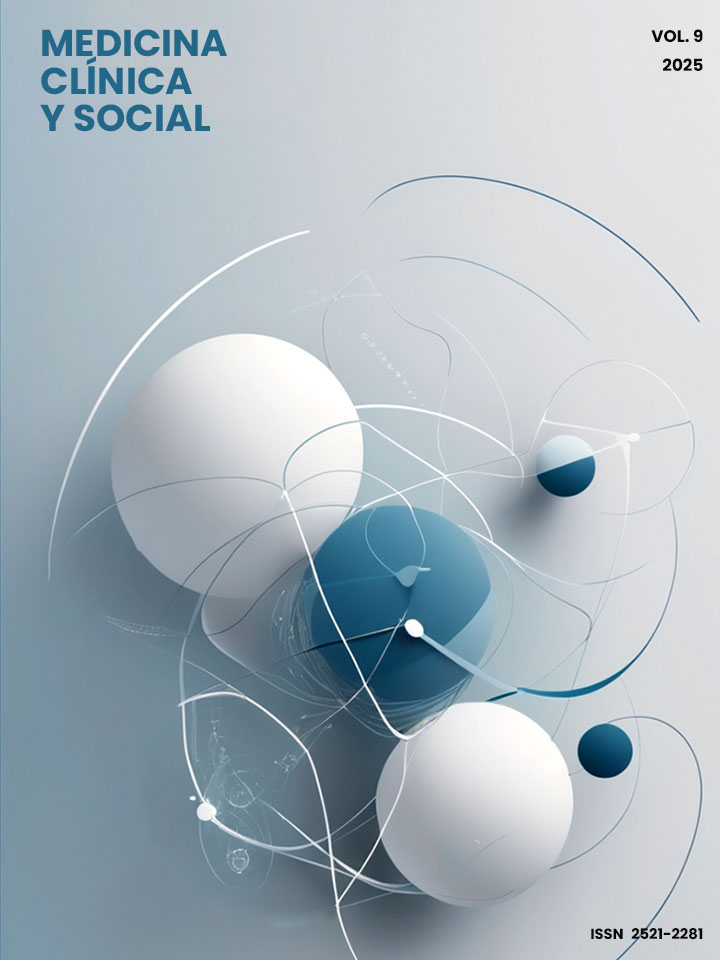Neovascularización coroidea secundaria a toxoplasmosis ocular activa: Reporte de un caso
DOI:
https://doi.org/10.52379/mcs.v9.592Palabras clave:
Neovascularización coroidea, tratamiento, toxoplamosis ocular, antiVEGFResumen
Paciente de 33 años, de sexo femenino, acudió a la clínica oftalmológica por disminución de la agudeza visual unilateral de aproximadamente cinco días de evolución, sin antecedentes previos. Al realizar el examen clínico-oftalmológico se encontró una lesión circunferencial elevada a nivel de la mácula, compatible con toxoplasmosis activa. Se decide iniciar tratamiento específico sistémico y adicionalmente con antiangiogénicos (antiVEGF) con lo que mejora el cuadro.
Descargas
Referencias
1. Vallochi AL, Goldberg AC, Falcai A, Ramasawmy R, Kalil J, Silveira C, Belfort R, Rizzo LV. Molecular markers of susceptibility to ocular toxoplasmosis, host and guest behaving badly. Clin Ophthalmol. 2008;2(4):837-48. https://doi.org/10.2147/opth.s1629
2. Hill D, Dubey JP. Toxoplasma gondii: transmission, diagnosis and prevention. Clin Microbiol Infect. 2002;8:634–40. https://doi.org/10.1046/j.1469-0691.2002.00485.x
3. Montoya JG, Remington JS. Toxoplasmic chorioretinitis in the setting of acute acquired toxoplasmosis. Clin Infect Dis. 1996;23:277–82. https://doi.org/10.1093/clinids/23.2.277
4. Adan A, Mateo C, Wolley-Dod C. Surgery for subfoveal choroidal neovascularization in toxoplasmic retinochoroiditis. Am J Ophthalmol 2003;135:386–387. https://doi.org/10.1016/s0002-9394(02)01947-5
5. Rosenfeld PJ, Saperstein DA, Bressler NM, et al. Photodynamic therapy with verteporfin in ocular histoplasmosis: uncontrolled open-label 2-year study. Ophthalmology 2004;111:1725–1733. https://doi.org/10.1016/j.ophtha.2004.02.014
6. Avery RL, Pieramici DJ, Rabena MD et al. Intravitreal bevacizumab (Avastin) for neovascular age-related macular degeneration. Ophthalmology 2006;113:363–372. https://doi.org/10.1016/j.ophtha.2005.11.019
7. Laud K, Spaide RF, Freund KB et al. Treatment of choroidal neovascularization in pathologic myopia with intravitreal bevacizumab. Retina. 2006;26:960–963. https://doi.org/10.1097/01.iae.0000240121.28034.c3
8. Teixeira A, Moraes N, Farah ME, Bonomo PP. Choroidal neovascularization treated with intravitreal injection of bevacizumab (Avastin) in angioid streaks. Acta Ophthalmol Scand 2006;84:835–836. https://doi.org/10.1111/j.1600-0420.2006.00762.x
9. Ben Yahia S. Intravitreal bevacizumab (Avastin) as primary and rescue treatment for choroidal neovascularization secondary to ocular toxoplasmosis. Int Ophthalmol 2008;28:311-6. https://doi.org/10.1007/s10792-008-9218-2
10. Robert-Gangneux F, Dardé ML. Epidemiology of and diagnostic strategies for toxoplasmosis. Clin Microbiol Rev. 2012;25:264–296. https://doi.org/10.1128/cmr.05013-11
11. Pappas G, Roussos N, Falagas ME. Toxoplasmosis snapshots: global status of Toxoplasma gondii seroprevalence and implications for pregnancy and congenital toxoplasmosis. Int J Parasitol. 2009;39:1385–1394. https://doi.org/10.1016/j.ijpara.2009.04.003
12. Holland GN. Ocular toxoplasmosis: a global reassessment. Part II: disease manifestations and management. Am J Ophthalmol. 2004;137(1):1–17. https://pubmed.ncbi.nlm.nih.gov/14700638/
13. Jasper S, Vedula SS, John SS, Horo S, Sepah YJ, Nguyen QD. Corticosteroids as adjuvant therapy for ocular toxoplasmosis. Cochrane Database Syst Rev. 2017;1(1):CD007417. https://doi.org/10.1002/14651858.cd007417.pub3
14. Holland GN. Ocular toxoplasmosis: a global reassessment. Part I: epidemiology and course of disease. Am J Ophthalmol. 2003;136(6):973–88. https://doi.org/10.1016/j.ajo.2003.09.040
15. Skorska I, Soubrane G, Coscas G. Toxoplasmic choroiditis and subretinal neovessels. J Fr Ophtalmol. 1984,7(3):211–218. https://pubmed.ncbi.nlm.nih.gov/6205043/
16. Atmaca L, Simsek T, Batioglu F. Clinical features and prognosis in ocular toxoplasmosis. Jpn J Ophthalmol. 2004;48:386–391. https://doi.org/10.1007/s10384-003-0069-0
17. Fine SL, Owens SL, Haller JA, Knox DL, Patz A. Choroidal neovascularization as a late complication of ocular toxoplasmosis. Am J Ophthalmol. 1981;91:318-322. https://doi.org/10.1016/0002-9394(81)90283-x
18. Rishi P, Venkataraman A, Rishi E. Combination photodynamic therapy and bevacizumab for choroidal neovascularization associated with toxoplasmosis. Indian J Ophthalmol. 2011;59:62–64. https://doi.org/10.4103/0301-4738.73728
19. Sivaprasad S, Moore AT. Choroidal neovascularisation in children. Br J Ophthalmol. 2008;92:451–454. https://doi.org/10.1136/bjo.2007.124586
20. Hegde S, Relhan N, Pathengay A, Bawdekar A, Choudhury H, Jindal A, Flynn HW Jr. Coexisting choroidal neovascularization and active retinochoroiditis, an uncommon presentation of ocular toxoplasmosis. Journal of Ophthalmic Inflammation and Infection. 2015;5:22. https://doi.org/10.1186/s12348-015-0051-2
21. Willerson D Jr, Aaberg TM, Reeser F, Meredith TA. Unusual ocular presentation of acute toxoplasmosis. Br J Ophthalmol. 1977;61:693–698. https://doi.org/10.1136/bjo.61.11.693
22. Kwak N, Okamoto N, Wood JM, Campochiaro PA. VEGF is major stimulator in model of choroidal neovascularization. Invest Ophthalmol Vis Sci. 2000;41:3158–3164. https://pubmed.ncbi.nlm.nih.gov/10967078/
23. Kennedy JE, Wise GN. Retinochoroidal vascular anastomosis in uveitis. Am J Ophthalmol. 1971;71:1221–1225. https://doi.org/10.1016/0002-9394(71)90966-4
24. Wise G. Uveitis with secondary retinal arteriosclerosis. Am J Ophthalmol. 1961;51:797–807. https://doi.org/10.1016/0002-9394(61)91816-5
25. Shahar J, Avery RL, Heilweil G, Barak A, Zemel E, Lewis GP, et al. Electrophysiologic and retinal penetration studies following intravitreal injection of bevacizumab (Avastin). Retina. 2006;26:262–269. https://doi.org/10.1097/00006982-200603000-00002
26. Lai TYY, Staurenghi G, Lanzetta P, Holz FG, Melissa Liew SH, Desset-Brethes S, Staines H, Hykin PG; MINERVA study group. Efficacy and safety of ranibizumab for the treatment of choroidal neovascularization due to uncommon cause: twelve-month results of the minerva study. Retina. 2018;38(8):1464-1477. https://doi.org/10.1097/iae.0000000000001744
27. Adán A, Mateo C, Navarro R, Bitrian E, Casaroli-Marano RP. Intravitreal bevacizumab (Avastin) injection as primary treatment of inflammatory choroidal neovascularization. Retina 2007;27: 1180–1186. https://doi.org/10.1097/iae.0b013e31815e9834
28. Mathur G, George AE, Sen P. Paediatric choroidal neovascular membrane secondary to toxoplasmosis treated successfully with anti-vascular endothelial growth factor. Oman J Ophthalmol. 2014;7:141–143. https://doi.org/10.4103/0974-620x.142598
29. Stanford MR, See SE, Jones LV, et al. Antibiotics for toxoplasmic retinochoroiditis: an evidence-based systematic review. Ophthalmology. 2003;110:926–31. https://doi.org/10.1016/s0161-6420(03)00083-6
30. Stanford MR, See SE, Jones LV, Gilbert RE. The involvement of autoimmunity against retinal antigens in determining disease severity in toxoplasmosis. J Autoimmun. 2005;24:25–32. https://doi.org/10.1016/s0161-6420(03)00083-6
31. Kianersi F, Naderi Beni A, Naderi Beni Z, Ghanbari H. Intravitreal bevacizumab for treatment of choroidal neovascularization secondary to toxoplasmic retinochoroiditis: a case series. Semin Ophthalmol. 2015;30(3):181-7. https://doi.org/10.3109/08820538.2013.838278
Descargas
Publicado
Número
Sección
Licencia
Derechos de autor 2025 Jenny Kam Lin Ku Lozano, Charles Gino Conde Obregon, Eduardo Maron Ku Lu, Margarita Samudio

Esta obra está bajo una licencia internacional Creative Commons Atribución 4.0.






